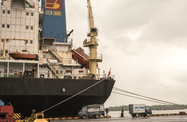With a rapidly expanding economy, the capacity for growth in both domestic and international trade is increasing Vietnam’s appeal to foreign operators in the logistics sector.

The economy grew by an average of 6.3% per year over the past decade, according to data issued by the Ministry of Industry and Trade in late May, with per capita incomes rising more than three-fold since 2007, climbing from $750 to $2445 by the end of 2016.
Much of this is due to expanding international trade, with exports increasing by 12-14% every year since 2007, when Vietnam joined the World Trade Organisation. Between 2007 and 2016 international trade rose to reach $350bn, according to the General Department of Vietnam Customs.
The more affluent economy also requires a larger and more serviceable logistics industry to cater to domestic demand. This represents an even broader market for local and international operators, as reflected by recent merger and acquisition activity in the sector.
To achieve this, Vietnam has gradually opened up its logistics sector to foreign involvement. The most significant step was taken in 2014, when the government removed requirements for licensed overseas companies to have a local partner. The only exception to this was for container handling and road transport services, for which a Vietnamese joint-venture partner was still required.
The subsequent liberalisation of the sector saw a steady influx of logistics firms into the Vietnamese market.
“The influence of foreign logistics operators is strong in Vietnam, having boosted productivity and facilitated knowledge transfer,” Tran Nguyen Hung, former CEO of multi-platform logistics firm Sea and Air Freight International, told OBG.
“This influx of overseas firms into the market has also seen many of the smaller operators lose market share, with the approximate 2000 local players accounting for only 25% of shipping volume. There’s a big imbalance in terms of market share. More than 80% of exports are run by international players. The foreigners bring the know-how and local players have to learn from it,” he added.
Potential attraction
Investments in logistics will continue to have a strong appeal for foreign companies, according to an April report issued by finance and advisory services firm Grant Thornton.
Based on a survey of foreign firms operating in Vietnam, investments were rated as being “very attractive”. This was attributed to the increasing influence of Western lifestyles and the rising disposable incomes in the country fuelling demand for goods and services.
The attractiveness is also being translated into spending, with foreign firms accounting for around $30bn-35bn of the total $37bn-40bn annual expenditure coming from the logistics sector.
High levels of international interest in the market were evidenced in mid-May, when South Korean conglomerate Taekwang Group issued a statement declaring its intent to acquire Gemadept, Vietnam’s largest logistics and port operations firm.
Upon Gemadept’s completion of the private offering to convert the overseas loans held by VIG Fund, the Ho Chi Minh City Stock Exchange-listed company is valued at VND12.5trn ($550m), with foreign investors holding 49% and domestic shareholders accounting for the remaining 51%.
Obtaining Gemadept would give Taekwang access to the Vietnamese firm’s network of logistics centres, including five operational ports, along with one deepsea container port and one river port in the developmental stage: the Gemalink in the south and the Nam Dinh Vu in the north.
Gemalink is scheduled to come on-line in 2019 and is expected to increase the company’s market share of port operations to 25% of the national total, up from the present level of 8%.
Customised streamlining
A gradual improvement in processing times for both imports and outbound freight and increased efficiency may also encourage investors, and to this end the General Department of Customs (GDC) announced improvements to its business environment in May.
These developments include streamlined processing procedures and enhanced online services, which should result in a marked reduction in clearance times for goods passing through Vietnam’s external trade hubs.
By year’s end, imports and exports should be able to clear customs in 90 and 70 hours, respectively. By 2020 these times are expected to be reduced by another 10 hours, the GDC said.
Currently, it takes 138 hours for imports to be cleared with exports requiring 108 hours, according to data from the Vietnam Logistics Association.
These improvements, if implemented as planned, will bring Vietnam’s freight clearance times closer in line with those of other countries in the region, boosting competitiveness, reducing costs for shippers and logistics operators, and spurring further investments.


